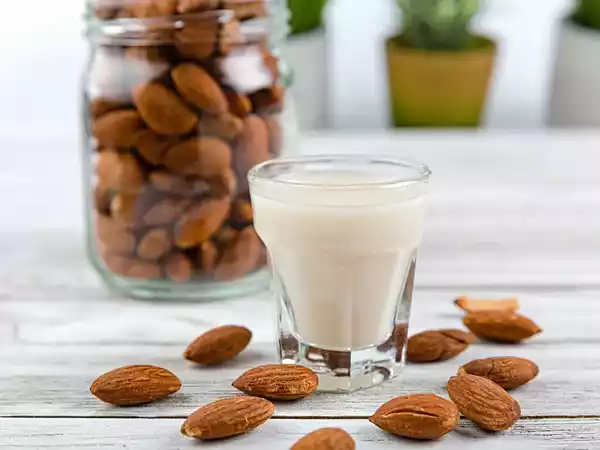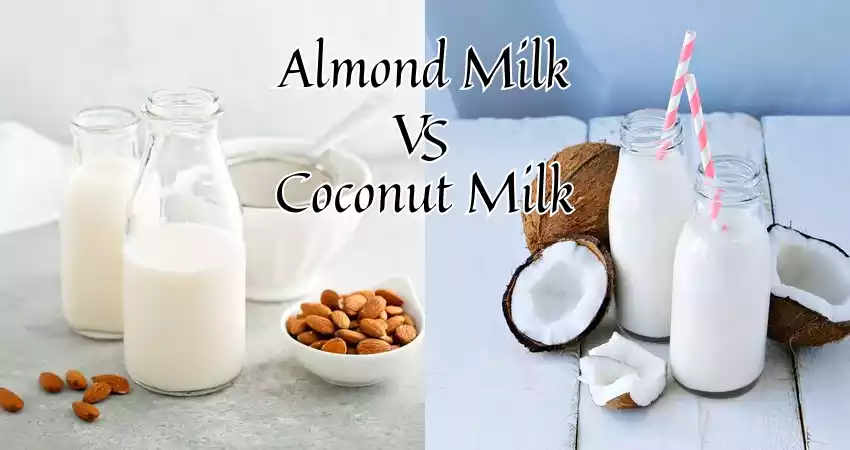In recent years, the shift towards plant-based diets has brought a surge in popularity for alternatives to traditional dairy milk. Among these, almond milk and coconut milk stand out as two of the most popular choices.
Each with its unique taste, nutritional profile, and culinary applications, these milks cater to a wide array of dietary preferences and needs. This exploration delves into the origins, nutritional content, health benefits, and environmental impact of almond and coconut milk, offering insights into how they differ and what makes each one unique.
What is Almond Milk?
Almond milk is a plant-based beverage made from ground almonds and water. It is a popular dairy milk alternative, especially among those who are lactose intolerant, vegan, or seeking a low-calorie option.
The process of making almond milk typically involves soaking almonds in water to soften them, then blending them with water and straining the mixture to remove solid particles. The result is a smooth, nutty-flavored liquid that resembles the consistency of traditional milk.

Nutritionally, almond milk is lower in calories and fat compared to cow’s milk, and it is naturally lactose-free. While it doesn’t naturally contain as much protein or calcium as dairy milk, many commercial varieties of almond milk are fortified with vitamins and minerals, including calcium and vitamin D.
Almond milk is versatile in use, suitable for drinking on its own, in coffee and tea, cereals, smoothies, and in various recipes as a dairy substitute. However, individuals with nut allergies need to avoid almond milk.
What is Coconut Milk?
Coconut milk can be described as a smooth and rich liquid that is extracted from the pulp of mature coconuts. It is a key ingredient in many tropical and Southeast Asian cuisines and is increasingly popular worldwide as a plant-based alternative to dairy milk. Unlike coconut water, which is the clear fluid found inside a young coconut, coconut milk is obtained by blending the coconut meat with water and then straining it to produce a milk-like consistency.
Nutritionally, coconut milk is high in calories and saturated fats, giving it a rich, creamy texture. It is naturally lactose-free, making it a suitable option for those with lactose intolerance or following a vegan diet. Coconut milk is distinct from coconut water and light coconut milk; the latter has a thinner consistency and lower fat content, often used in cooking rather than as a beverage.

Coconut milk is used in a variety of culinary applications, from thickening soups and curries to adding creaminess to beverages and desserts. Its unique flavor profile, which is subtly sweet and nutty, makes it a favored ingredient in dishes that require a rich, creamy texture. Despite its high-fat content, coconut milk can be part of a healthy diet when consumed in moderation and offers a flavorful alternative for those seeking dairy-free options.
Comparison chart – Almond Milk vs Coconut Milk
| Attribute | Almond Milk | Coconut Milk |
|---|---|---|
| Origin | Made from ground almonds and water. | Made from the grated pulp of mature coconuts. |
| Texture and Flavor | Generally lighter and has a nutty flavor. | Creamier and richer, with a subtly sweet and nutty taste. |
| Nutritional Content | Lower in calories and fat. Often fortified with vitamins and minerals. | Higher in calories and saturated fats. |
| Protein Content | Typically lower in protein. | Also, lower in protein compared to dairy milk. |
| Carbohydrate Content | Lower in carbohydrates. | Varies, but generally low in carbs unless sweetened. |
| Fat Content | Low in fat. | High in saturated fat. |
| Caloric Value | Generally lower in calories. | Higher calorie content due to fats. |
| Dietary Benefits | Lactose-free, often used by vegans and those with dairy allergies. | Lactose-free, suitable for vegans and those with lactose intolerance. |
| Culinary Uses | Versatile in drinks, cereals, and cooking. | Used in soups, curries, desserts, and beverages. |
| Environmental Impact | Concerns over water use in almond farming. | Less water-intensive, but has other environmental considerations. |
| Allergy Concerns | Not suitable for people with nut allergies. | Generally safe, but may not be suitable for those with specific coconut allergies. |
Similarities – Almond Milk and Coconut Milk
- Both almond milk and coconut milk are plant-based alternatives to dairy milk.
- They are suitable for those suffering from lactose intolerance or allergies to dairy.
- Many brands enrich both milks with vital minerals and vitamins like calcium and vitamin D.
- Both can be employed in many recipes, such as baking, smoothies, and cooking.
- The HTML0s offer a smooth texture, which makes them ideal for tea and coffee.
- Almond and coconut milk are vegan-friendly and don’t contain animal products.
- They are cholesterol-free and naturally occurring.
- Milk cartons that have not been opened can be stored in unopened containers for an incredibly long shelf-life.
- Both can be used as a single replacement for milk that is dairy-free in a majority of recipes.
- Some brands offer flavors that are flavored, like chocolate and vanilla, which are available for both milk types.
Origin and Production: Almond Milk vs Coconut Milk
Almond milk and coconut milk, both popular plant-based alternatives to dairy milk, have unique origins and production processes. Almond milk is created from almonds, which are soaked in water, and ground, and then strained to produce a milky, nutty-flavored liquid. This process involves blending the softened almonds with water and filtering out the solid particles, resulting in a smooth drink that’s lower in calories and fat compared to cow’s milk.
On the other hand, coconut milk is made from the grated pulp of mature coconuts. The coconut meat is blended with water and strained, yielding a creamy, rich liquid. This milk is integral to tropical and Southeast Asian cuisines, known for its high calorie and saturated fat content, and is used in a variety of dishes for its unique sweet and subtly nutty flavor. Both these milk are dairy-free and have become increasingly popular in various culinary contexts, catering to a range of dietary preferences and needs.
Nutritional Comparison
Calories: Almond milk is typically lower in calories than coconut milk. A cup of unsweetened almond milk can contain as little as 30-50 calories, whereas a cup of unsweetened coconut milk usually has around 50-80 calories.
Fat: Coconut milk is higher in fat, especially saturated fat. Almond milk generally contains around 2.5 grams of fat per cup, most of which is unsaturated, while coconut milk can have about 5 grams per cup, with a higher proportion of saturated fat.
Protein: Almond milk provides a modest amount of protein, typically around 1 gram per cup. Coconut milk, on the other hand, is very low in protein, often containing less than 1 gram per cup.
Carbohydrates: Both almond milk and coconut milk are low in carbohydrates, but almond milk usually has slightly more, with about 1-2 grams per cup compared to less than 1 gram in coconut milk.
Vitamins and Minerals: Many commercial brands of almond and coconut milk are fortified with vitamins and minerals such as calcium, vitamin D, and vitamin B12. Almond milk often contains vitamin E naturally, while coconut milk is a good source of certain medium-chain triglycerides (MCTs), which may offer health benefits.
Dietary Fiber: Both almond milk and coconut milk are low in fiber, with typically less than 1 gram per serving.
Almond milk is a low-calorie, low-fat option with a bit more protein and carbohydrates, while coconut milk is higher in fat and calories, with negligible protein. Both can be enriched with vitamins and minerals and cater to those looking for lactose-free, vegan milk alternatives.
DIY Milk Making
Making your own almond milk or coconut milk at home is a simple and rewarding process.
For Almond Milk:
- Soak a cup of raw almonds in water overnight.
- Drain and rinse the almonds, then blend them with about 3-4 cups of water.
- Strain the mixture using a nut milk bag or cheesecloth to separate the pulp from the milk.
- Optionally, add sweeteners or flavorings like vanilla or honey, and blend again.

For Coconut Milk:
- Blend the meat of one mature coconut with 2-3 cups of hot water.
- Strain the mixture through a cheesecloth or nut milk bag to extract the milk.
- For a thinner consistency, add more water.

Health Benefits – Almond Milk vs Coconut Milk
Almond milk and coconut milk offer different health benefits, making them appealing for various dietary needs. Almond milk is a great option for those looking to reduce calorie intake or manage weight, as it’s low in calories and fat.
It’s also often enriched with vitamins and minerals, such as calcium and vitamin D, which are important for bone health. The presence of vitamin E in almond milk helps in maintaining healthy skin and eyes, and its low sugar content makes it a good choice for those monitoring their blood sugar levels.
On the other hand, coconut milk is rich in medium-chain triglycerides (MCTs), which are thought to aid in metabolism and could potentially support weight management. Its high content of saturated fats, while a concern for some, can also be beneficial for boosting good cholesterol levels in moderation. Coconut milk is also lactose-free, making it a suitable choice for those with lactose intolerance or dairy allergies.
Both almond and coconut milk are vegan-friendly and can be part of a heart-healthy diet when consumed in moderation.
Taste and Culinary Uses -Almond Milk vs Coconut Milk
Almond milk and coconut milk, each with their distinctive tastes, are versatile in the kitchen, catering to a variety of culinary uses. Almond milk has a light, slightly nutty, and sweet flavor, making it a popular choice for everyday use. It’s great in coffee, tea, and smoothies, and can easily replace dairy milk in cereals, baking, and cooking, without significantly altering the taste of the dish. Its subtle flavor also makes it a good base for homemade sauces and dressings.
Coconut milk, on the other hand, is richer and creamier with a distinct sweet, coconut flavor. It’s a staple in many tropical and Asian cuisines, commonly used in curries, soups, and stews to add creaminess and a hint of sweetness. Coconut milk is also a favorite in desserts, from creamy puddings to tropical smoothies, and can be used in making dairy-free whipped cream. Its unique taste can be a standout feature in recipes, adding a touch of tropical flair to the dishes it’s used in.
Both almond milk and coconut milk offer delightful alternatives to dairy, allowing for creative culinary exploration while catering to different flavor profiles and dietary needs.
Allergies and Dietary Restrictions
Almond milk and coconut milk are popular dairy-free alternatives, but they come with considerations for allergies and dietary restrictions. Almond milk should be avoided by individuals with nut allergies, as it’s made from almonds, which are tree nuts.
Coconut milk, though technically a fruit, can also trigger allergies in some people, particularly those with specific sensitivities to coconut. Both are suitable for vegans and those lactose intolerant, providing a plant-based option free from animal products and lactose.
Price and Availability: Almond Milk vs Coconut Milk
Almond milk and coconut milk are widely available in most grocery stores, health food stores, and online retailers, reflecting their popularity as dairy alternatives. Typically, almond milk is slightly more affordable and can be found in various forms, such as sweetened, unsweetened, flavored, and fortified with vitamins and minerals.
Coconut milk is also readily available but might be slightly more expensive, especially the canned varieties often used in cooking. Prices for both can vary based on brand, organic certification, and additional ingredients. The widespread availability of both almond and coconut milk makes them easily accessible for consumers looking to explore dairy-free alternatives.
Consumer Preferences
Consumer preferences for almond milk and coconut milk vary based on taste, dietary needs, and intended use. Almond milk is often favored for its lower calorie content and mild, nutty flavor, making it a popular choice for everyday drinking, cereal, and coffee. Its versatility and availability in several flavored and fortified versions also appeal to a broad audience.
Coconut milk, with its rich, creamy texture and distinctive coconut flavor, is preferred by those looking for a more flavorful alternative to dairy milk. It’s particularly popular in cooking and baking, where its richness enhances the taste and texture of dishes, especially in Asian and tropical cuisines.
Health-conscious consumers lean towards almond milk for its lower fat content, while those looking for a richer, creamier taste or specific culinary applications might prefer coconut milk. Both are sought after by vegans and those with lactose intolerance, offering lactose-free, plant-based alternatives to dairy milk. Personal preference plays a significant role, with some consumers choosing based on taste alone, while others consider nutritional aspects or specific dietary restrictions.
Which is healthier almond milk or coconut milk?
Determining which is healthier between almond milk and coconut milk largely depends on your dietary goals and health needs. Almond milk is generally lower in calories and fat, making it a better choice for those looking to manage their weight or reduce calorie intake.
It also often contains added vitamins and minerals. Coconut milk, while richer in saturated fats and calories, contains medium-chain triglycerides (MCTs) that may offer metabolic benefits. However, its high saturated fat content might be a concern for those monitoring heart health.

Both are lactose-free and vegan, making them good alternatives for those with dairy intolerance or following a plant-based diet. In summary, almond milk is typically the healthier option for weight management and lower calorie diets, while coconut milk can be beneficial in moderation, especially for those requiring higher energy intake.
Conclusion
Coconut milk and almond milk are both well-known alternative dairy products made from plants with distinct nutrition profiles, tastes, and culinary uses. Almond milk is well-known for its lower calories as well as fat percentage, which makes it an ideal option for people who are watching their weight or seeking a more light sweet, nutty flavor.
Coconut milk’s smooth and creamy texture is a great choice for those looking for a more flavorful alternative, particularly in baking and cooking. Both are vegan and lactose-free catering to a range of food preferences and needs.
The decision between these two usually depends on your personal preference in addition to health issues and the purpose for which they are used. Making this milk yourself can be a pleasant and simple method of enjoying these dairy alternatives while ensuring the quality of the ingredients and freshness.

